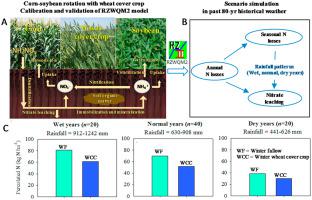Journal of Cleaner Production ( IF 11.1 ) Pub Date : 2020-09-17 , DOI: 10.1016/j.jclepro.2020.124255 Wei Yang , Gary Feng , Ardeshir Adeli , Haile Tewolde , Zhongyi Qu

|
Soil nitrogen dynamics is affected by the interaction of cover crops and rainfall amount and distribution in rainfed agricultural production systems. There is a lack of understanding on soil nitrogen losses from cover crop-based based cropping systems receiving different rainfall amounts. A simulation model, RZWQM2 (Root Zone Water Quality Model), was calibrated and validated with field measurements, and used to determine the long-term effect of a winter wheat (Triticum aestivum L.) cover crop on soil nitrogen balance in an 80-yr (1938–2017) no-tillage and rainfed corn (Zea mays L.)–soybean (Glycine max L.) rotations in northeastern Mississippi, United States. Based on annual soil nitrogen dynamics, the model also estimated nitrate losses to deep percolation during wheat, corn, and soybean growth periods under different seasonal rainfall patterns. A record of seasonal rainfall for 80 consecutive years (1938–2017) was classified as ‘wet’, ‘normal’, ‘dry’ years using frequency analysis approach, and the classifications were matched chronologically to each of these three crop growth periods as model input parameters. Results showed that, mean annual net nitrogen mineralization and annual denitrification were respectively 15% and 9% higher under wheat cover crop (WCC) than under winter fallow (WF) across 80 simulation years. Average annual nitrate leaching was 20% less in the WCC than in the WF system (68.2 vs. 84.8 kg N ha−1). The difference in annual nitrate leaching between the two treatments is equivalent to 17% of the total fertilizer nitrogen-applied annually for corn-soybean system. Compared to WF, the WCC system during autumn to spring (early October to early April) reduced simulated annual nitrate leaching losses by 19.6, 18.6, and 8.2 kg N ha−1 in wet, normal, and dry years, respectively. Long-term integration of wheat cover crop into a no-till corn-soybean rotation is a promising agronomic practice for reducing nitrate leaching and also fertilizer-nitrogen input in the humid northeastern Mississippi, especially in wetter fallow seasons from early October to early April.
中文翻译:

不同降雨方式下小麦覆盖作物对免耕玉米-大豆轮作土壤氮素损失的长期影响模拟
雨养农业生产系统中覆盖作物与降雨量和降雨分配之间的相互作用会影响土壤氮的动态。对基于覆盖作物的种植系统收到不同降雨量的土壤氮损失缺乏了解。模拟模型RZWQM2(根区水质模型)已通过实地测量进行了校准和验证,并用于确定冬小麦(Triticum aestivum L.)覆盖作物对80年代土壤氮平衡的长期影响年(1938–2017)免耕和雨育玉米(Zea mays L。)–大豆(Glycine maxL.)在美国密西西比州东北部的轮换。根据年度土壤氮动态,该模型还估算了不同季节降雨模式下小麦,玉米和大豆生长期间硝酸盐在深层渗滤中的损失。使用频率分析方法,将连续80年(1938-2017年)的季节性降雨记录分为“湿”,“正常”,“干”年,并按时间顺序将这三个作物生长期分别作为模型进行分类输入参数。结果表明,在80个模拟年中,小麦覆盖作物(WCC)的年均净氮矿化度和年反硝化率分别比冬季休耕(WF)高15%和9%。WCC的年硝酸盐平均浸出量比WF系统少20%(68.2 vs. 84.8 kg N ha-1)。两种处理之间的年度硝酸盐淋失差异相当于玉米-大豆系统每年施用的总肥料氮的17%。与WF相比,秋天到春季(10月初到4月初)的WCC系统在潮湿,正常和干旱年份分别将模拟的年度硝酸盐淋失损失减少了19.6、18.6和8.2 kg N ha -1。长期将小麦覆盖作物整合到免耕玉米-大豆轮作中,是一种有希望的农业实践,可减少密西西比东北部潮湿的土地中的硝酸盐淋失以及肥料氮的输入,尤其是在十月初至四月初的潮湿休耕季节。



























 京公网安备 11010802027423号
京公网安备 11010802027423号